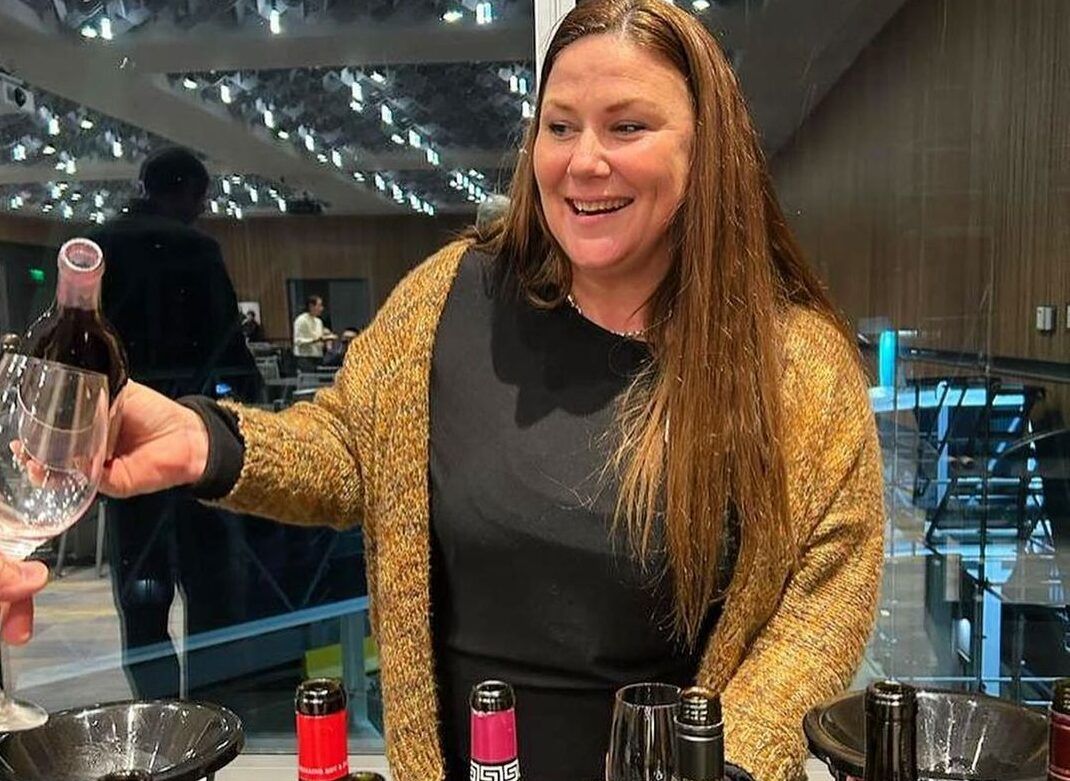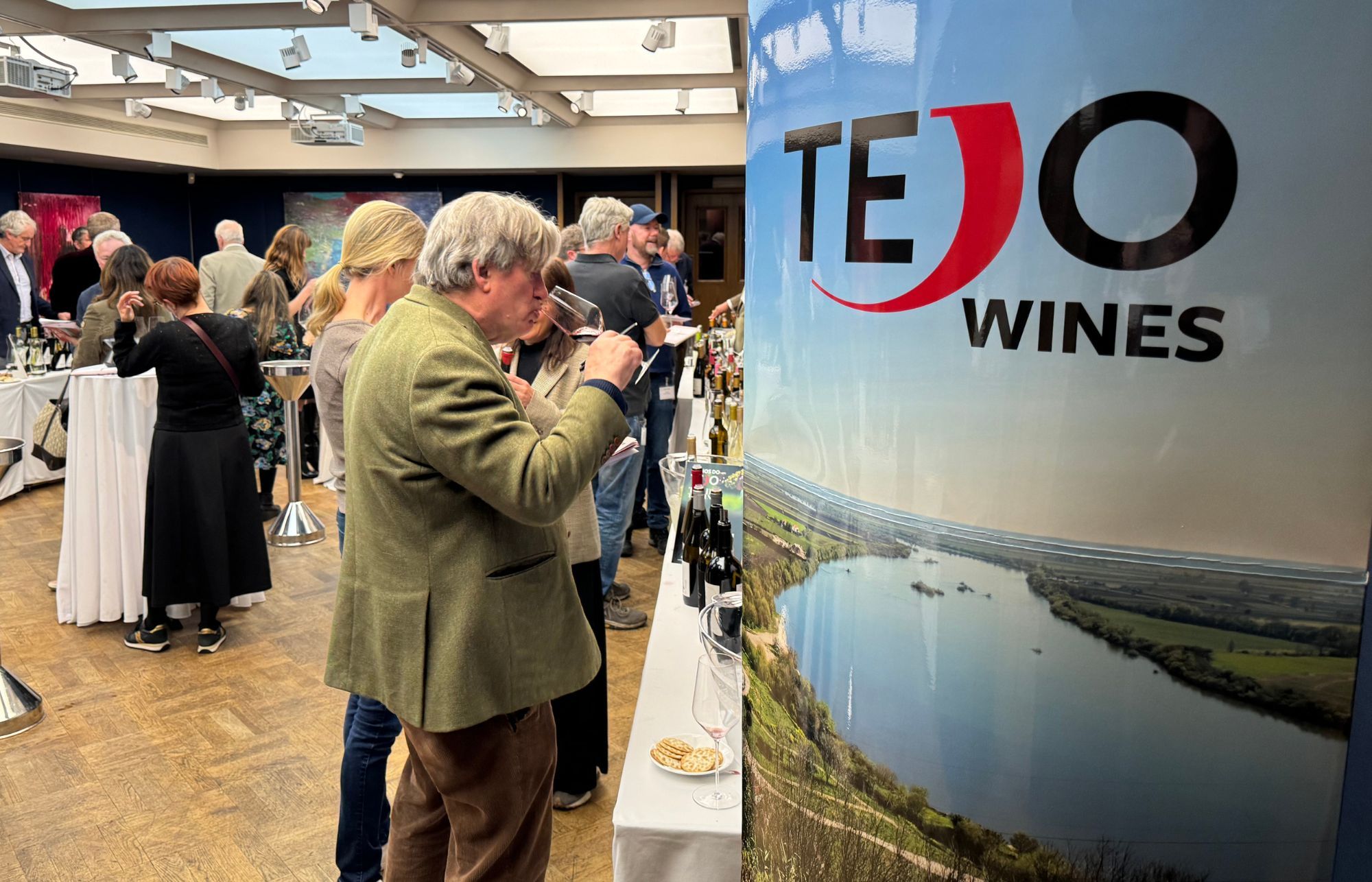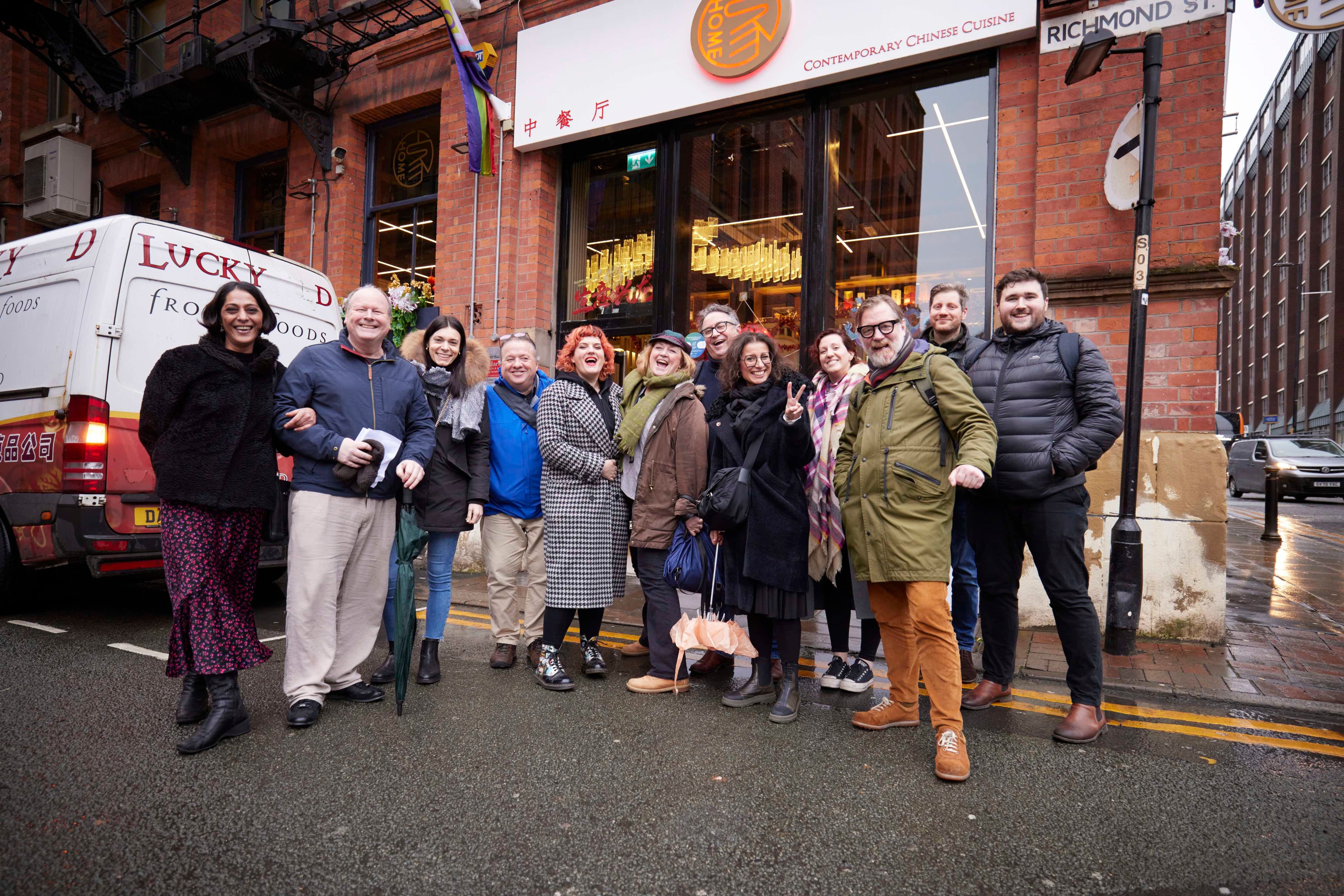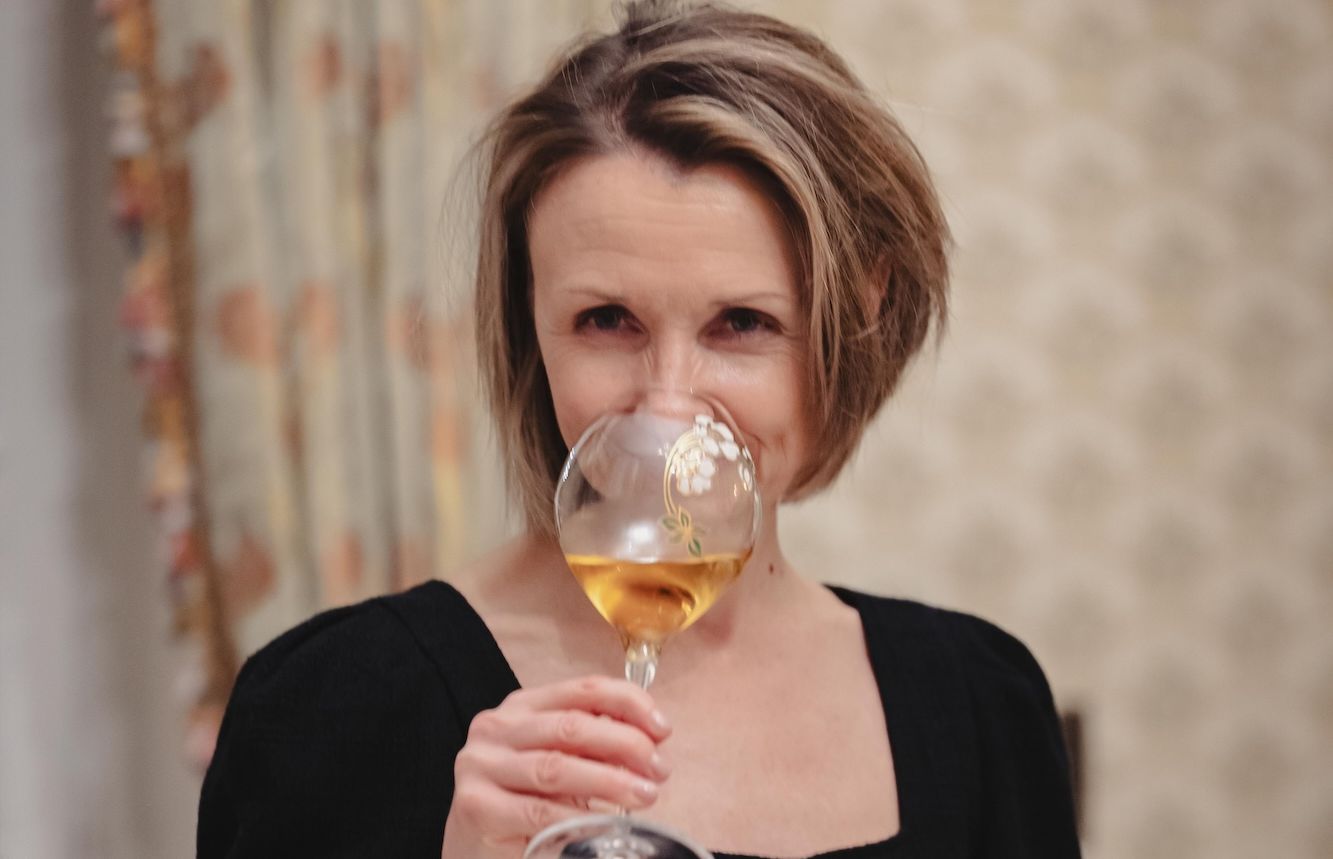“When the harvest in New Zealand is finished you can jump straight on a plane and head over to work on the next vintage in Oregon, and many do. The similarities in climate and topography are there to see,” says McCombie.
When the Wines From The Edge tasting came up, I jumped at the chance to attend. On the one hand I’ve been a huge fan of New Zealand wines for a number of years now, even once getting lucky enough to visit that glorious country on a whistle-stop tour that took in nearly every wine region that could be squeezed into two weeks. Fabulous trip, fabulous wines, fabulous people, loved it. On the other hand, there’s Oregon. Other than what I’ve read in my WSET studies I know next to nothing about America’s 4th biggest wine producing state. This tasting gave me the chance to be a fan boy on one side, and an eager wine geek desperate for knowledge on the other.
Wines From The Edge
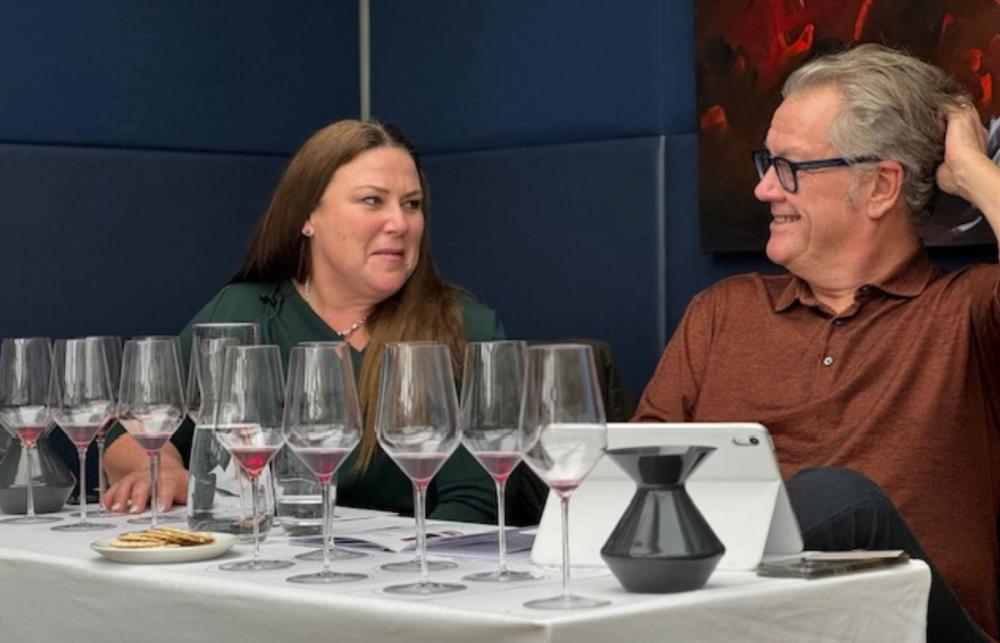
Bree Stock MW and Peter McCombie MW
The Wines From The Edge tasting was a joint presentation from the teams at New Zealand Wine and Oregon Wine, with a masterclass and tasting comparisons run by one of New Zealand’s finest exports in Peter McCombie MW and Oregon-based Aussie guru Bree Stock MW. The opening of the masterclass itself addressed the question on everyone’s lips, what’s behind this tie-up?
Shared climate, topography and commitment to sustainability
The title Wines From The Edge refers to the limits of latitude where both sets of grape growers and winemakers ply their trade. The latitude of wine regions of the world tend to lie somewhere inbetween the 30th and 50th parallels, north and south of the equator. Those wine regions towards the edge of that range have historically been able to produce moments of fabulous quality, but being on the margins of climate means year in year out consistency might have been an issue. They were restricted to certain grapes and wine styles. With the change in climate, however, these Wines From The Edge are more consistent and higher quality than ever before. With Oregon sitting between the 42-46th parallel north and New Zealand between the 36-46th parallel south, the shared experience is obvious.
This shared experience is much more than just climatic. “It’s very common for winemakers to move between the countries to work on projects both sides of the Pacific,” noted McCombie. “When the harvest in New Zealand is finished you can jump straight on a plane and head over to work on the next vintage in Oregon, and many do. The similarities in climate and topography are there to see.”
The shared commitment to sustainability is also something that was heavily stressed by all. Sustainable Winegrowing New Zealand was one of the first and is arguably one of the most famous sustainability programmes in our industry. Oregon too, with its Oregon Certified Sustainable Wines programme, is not only keen to point out its own future-proofing credentials, it’s something that’s clearly vital to the local economy.
“There are so many cynics about sustainability, but both these places are ongoing and dynamic,” rallied Stock. “In Oregon more than 50% of the wineries are smaller, family-owned operations of less than 5,000 cases per year. These families are living on the estates and the towns and villages are filled with friends and neighbours in the industry. As well as all the other definitions, we know we need to be serious about community sustainability more than most.”
The rise of Oregon wines
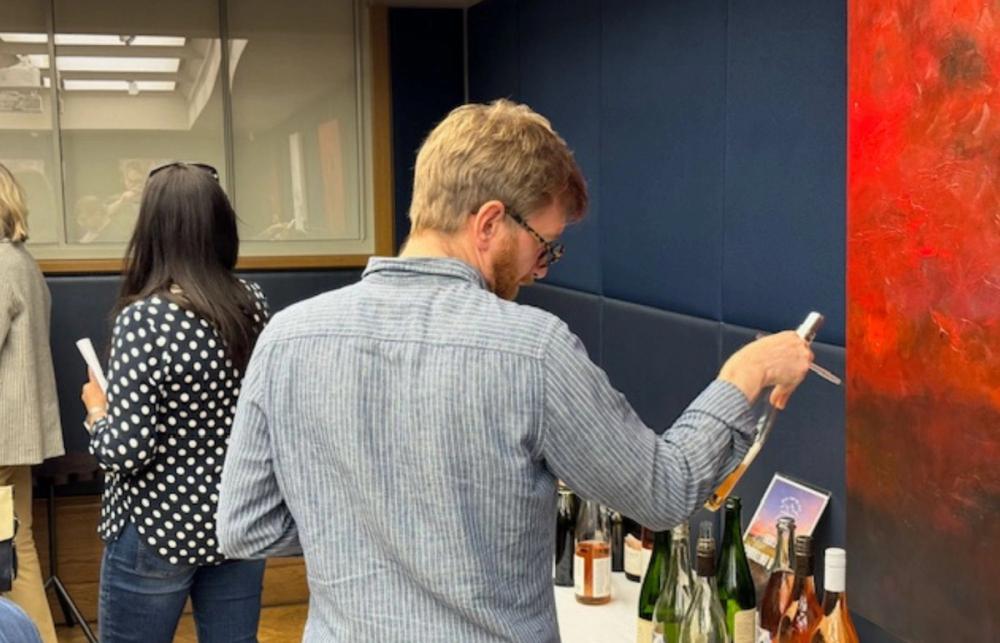
Trying out the wines of Oregon
The State of Oregon sits on the Pacific North-West Coast, wedged between California to the South and Washington State to the North. Stock revealed how, coming from Australia, the rolling green hills, wind and rain were a shock to her system, but they define the State’s ability to produce fine, cool climate wines.
“It’s small compared to California, but so is everywhere!” joked Stock. In numbers, Oregon produces only 2% of the wines of the USA. Its modern wine industry is relatively young, with most current, commercial plantings only beginning in the 1950s post-prohibition, and it wasn’t until the 1970s that international recognition arrived with high placed Pinot Noirs across global competitions. But since then, the rise has been fast, highlighted by the roughly 1150 wineries now producing wines, which is almost ten times the amount there were in 2000.
Similar to New Zealand, one grape variety dominates production. In Oregon’s case, that’s Pinot Noir at around 60% of the plantings. Such is the reputation and demand for Oregon’s Pinot Noir, that in 2022 around 30% of the harvested grapes were bought and transported to wineries outside of the State for crushing and fermentation. Vineyards are spread across 23 AVAs (American Viticultural Areas), with 12 nested within the larger and most famous Willamette Valley AVA. The climate, towards the coast at least, is defined by both the cool currents from Alaska down the coastline, bringing cooling coastal breezes and the occasional Pacific Storm in through gaps in the Coastal Mountain Ranges, as well as the altitude from the mountains and river valleys themselves. Cool climate grape varieties, of which Pinot Noir is one of the more famous, have every opportunity to thrive.
Comparing the wines of Oregon and New Zealand
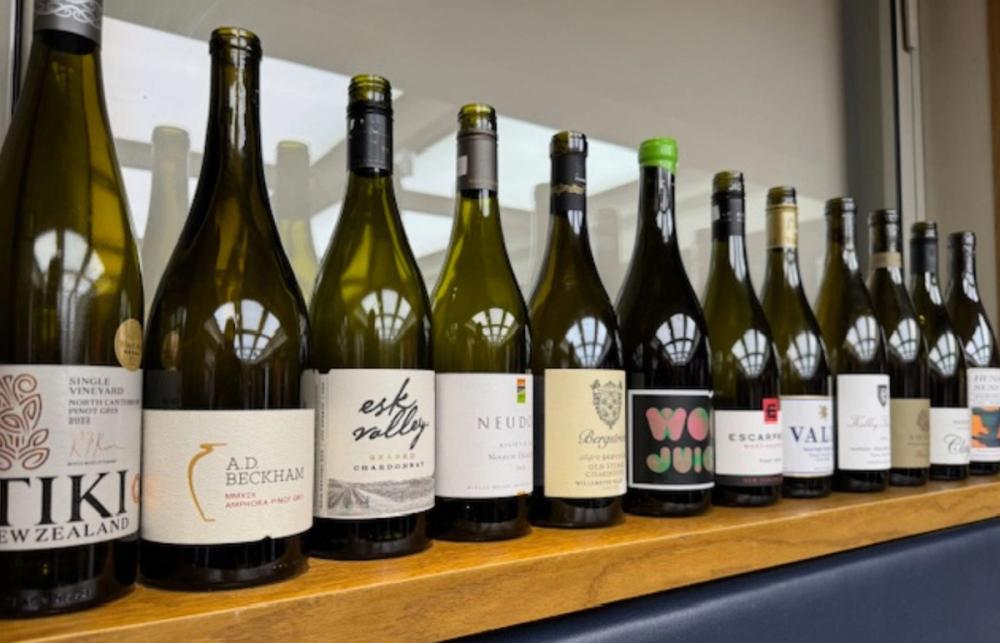
Wines From The Edge masterclass line-up
The latitudes of both countries help provide the most distinguishing feature of the wines.
“It’s all about daylight,” revealed McCombie. “Both these places get about 15 hours of daylight in the growing season. That enhanced UV light gives them a lot more physiological ripeness, as well as darker, thicker skins.”
Soils too define many wine styles, with Oregon in particular showing a real distinction of flavours.
“The two main soil types in Oregon are marine and volcanic,” explained Stock. “About 200 million years ago, the Juan de Fuca and North American tectonic plates hit and raised Oregon up out of the sea giving ancient marine bedrocks.
The marine-origin sedimentary soils are both low in fertility and free draining. This often results in restrained flavours but, nonetheless, complex wines. Then volcanic eruptions around 10-50 million years ago, especially around the Cascade Mountains gave us the other prevalent soil type, the volcanic soils that are more water-retentive and great for the dry farming practised across the State. Those wines tend to be more fruit-forward and juicy.”
Pinot Gris and Chardonnay
The masterclass itself focused on four main grape varieties, which began with whites from Pinot Gris and Chardonnay. Pinot Gris, made in the more full-bodied Alsatian style in both New Zealand and Oregon, are not the main white grapes by a long shot, with 6% and 13% of each area’s plantings respectively. But with younger winemakers in Oregon looking to preserve old vine Pinot Gris from being grubbed up and replaced with Chardonnay, and New Zealand winemakers enjoying the graceful perfume produced by those hours of sunlight, both Stock and McCombie saw bright futures ahead for the variety.
The other white wine served up for comparison and contrast was Chardonnay. Like many areas of the world, both New Zealand and Oregon are currently in the process of defining their styles, which had been influenced heavily in the past by their close neighbours California and Australia.
“A lot of work has been done with clones and now more plantings at altitude,” revealed Stock. “There’s a definite style shift towards more acid and less oak, and within the nested AVAs of Willamette Valley we’re starting to see some very unique styles from cooler climate Chardonnay.”
McCombie pointed to New Zealand’s ability to produce wines of abundant natural acidity to promote the same stylistic shift in both North and South Island.
Pinot Noir and Syrah
Although New Zealand is dominated by Sauvignon Blanc, and white wines account for about 75% of plantings, Pinot Noir remains its most planted black grape variety. Planted up and down the country, certain regions have become famous for a defined style of Pinot Noir, including the likes of Wairarapa in the North Island and Central Otago in the South Island now being joined by the likes of North Canterbury and Waitaki. In Oregon, however, Pinot Noir is the main player around with 80% of the planted grapes in Willamette Valley alone.
“It was the most consistently planted variety after prohibition,” explained Stock. “Oregon Pinot Noir was pretty much the first commercialised Pinot Noir in the USA, with lots of work being done on promoting the message of cool climate varieties.”
Within the Willamette Valley, stylistic camps have evolved, with old vine Pinot Noir from the loess and sand soils of Tulatin and Lakewood to the north producing more heft and deeper blue fruits, and the volcanic soils in the middle of the region producing more red-fruited and spiced wines for earlier drinking.
The bigger surprise, for two areas known more for their cool climate wines at least, was the final set of comparisons. A Syrah from the Southern Valleys of Marlborough contained all the green pepper tang and freshness that first saw Hawke’s Bay Syrah catching the eye of an interested wine public. Nestled inland in the Walla Walla AVA sits Rock District of Milton Freewater AVA, the second smallest AVA in the USA which has become a haven for Rhône varieties in this warmer area further from coastal influence.
“I think if you’re really desperate for a comparison maybe think more Côte Rôtie style of Syrah, obviously without the co-fermentation,” mused Stock. “But it’s a deep, alluvial riverbed and I always feel like I get grilled meat notes and coffee beans that must come from the stones and heat. It’s been a huge hit with US sommeliers.”
Top picks from the wines on show
As well as the masterclass, we were treated to a free pour tasting of wines from across the regions of New Zealand and AXAs of Oregon. The following are some impressive wines that I think would be great additions to anyone’s wine lists.

Smith & Sheth Heretaunga Chardonnay 2019, Hawke’s Bay, New Zealand
This is Chardonnay right up my street. Every aroma started subtle and just kept building in the glass. Stoney minerality, smoke, subtle vanilla notes from well-judged oak choices, but all adding rather than taking away from concentrated stone and tropical notes with excellent balanced acidity. Big fan. Imported by Louis Latour Agencies, RRP £35.99
Domaine Drouhin Oregon, Roserock Chardonnay 2021, Oregon
When you taste Chardonnay from anywhere in the world, you can’t help but mentally compare them to other Chardonnays you’ve tasted from…well…let’s be honest, Burgundy. And when the wine’s made by a Burgundian legend the comparisons are impossible to avoid. This wine transported me to some of the best Grand Cru Chablis I’ve been lucky to taste. Concentrated green and stone fruits, as well as excellent lees texture and grip to coat the palate and give that all important balance to the acidity. RRP £44.00
Clos Henri Estate Pinot Noir 2021, Marlborough, New Zealand
From the clay-heavy Southern Valleys of Marlborough comes this super fruit-driven wine with bags of red cherry and raspberry notes, black pepper, and lots of crunchy red fruits on the finish. Those soils give this one a slightly fuller body than most Pinot Noirs making this an excellent foodie wine, and great value at a snip over twenty quid. Imported by Les Caves de Pyrene, RRP £20.49
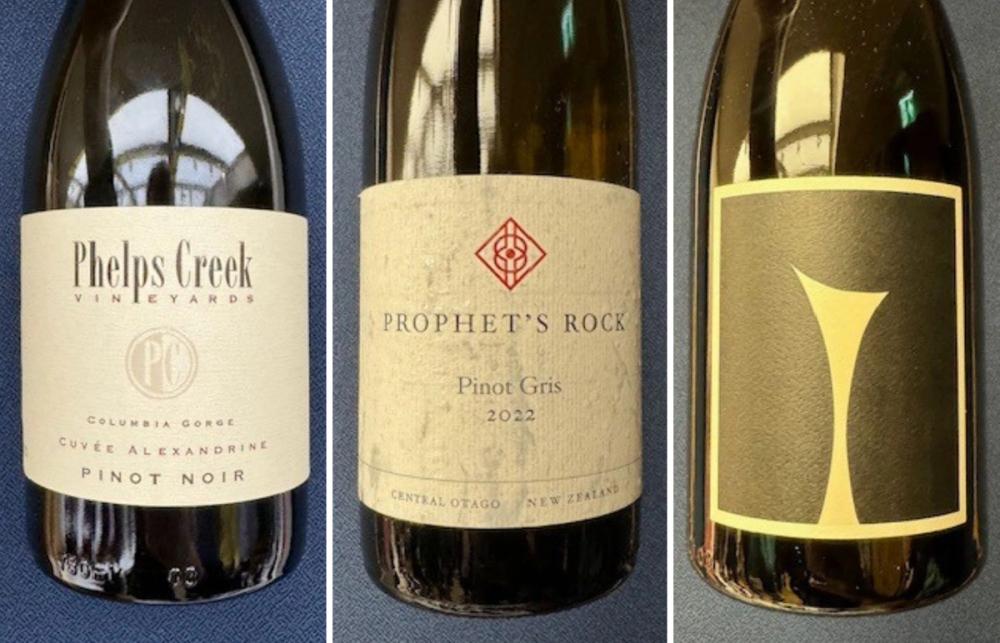
Phelps Creek, Cuvée Alexandrine Pinot Noir 2021, Oregon
Going to assume this one was from a fairly volcanic set of soils, with another Pinot Noir choice from me with lush red fruits, but a smokey and peppery finish as well as a little more tannic grip, which I really think makes any Pinot stand out in the line from others. POA
Prophet’s Rock Pinot Gris 2022, Central Otago, New Zealand
Loved all the Pinot Gris that I got to try on the day but this one from Prophet’s Rock edged it by a nose. Really perfumed with blossom, ginger, stone and tropical notes. Like others on the day there was a touch of residual sweetness to add balance and body, making this a really top option for spicy seafood dishes. Imported by Jascots, RRP £28.00
Artist Block, Thicc Sister Syrah 2022, Dundee Hills, Oregon
I genuinely didn’t know when I’d picked this wine as one of my favourites that it was actually made by Bree Stock MW herself! From the coveted slopes of Dundee Hills AVA this wine is full of spicy red fruits, black pepper, violet petal, as well as that touch of meatiness that Stock loves so much in her Oregon Syrahs. Really juicy on the palate and lovely acidic balance. RRP £36.00
Roger Jones, retired Michelin star chef and wine judge, adds his highlights from this tasting.
Pinot Gris
Tiki Single Vineyard North Canterbury Pinot Gris, 2022
Fresh crisp apple, juicy with a creamy background, delicate herbaceous notes, hint of bitter sweetness in a good way, classic dry Alsace style, exceptional. Castelnau Wine Agencies, RRP £17.00
Prophets Rock Pinot Gris 2022, Central Otago
Juicy and fresh with a clean fresh fruity focus, joyful and a great wine to go with oysters, razor clams or cockles, fresh citrus notes give it a lovely kick. Jascots RRP £28.00
Beckham Estate, AD Beckham Pinot Gris Rose 2019
This has skin contact and quite a funky style, there are ‘Campari’ notes with clementine zest, hints of toasty marmalade, not as clean cut and refreshing as Tiki, but with food such as Wild Mushroom and Truffle Risotto would hit the spot. RRP £38.00
Chardonnay
Neudorf Rosie’s Block Monterey Chardonnay 2022, Nelson
Neudorf, like Kumeu River, has certainly put New Zealand Chardonnay on the world stage, and this Rosie’s Block is no exception; gentle use of high quality oak brings together delicate flint notes with a perfect purity of white peeled stone fruit, with a delicate white nutty note. The texture is a point.Bibendum, RRP £35.00
Blank Canvas Reed Vineyard Chardonnay 2022, Marlborough
Forward, bright, full of juicy stone fruit, succulent white peaches, nectarines and hint of delicate Alphonse mango, love the purity and freshness of this wine. Liberty, RRP £33.99
Smith & Sheth Heretaunga Chardonnay, 2019, Hawke’s Bay
Restrained elegance, very Burgundian with hints of glazed pineapple, nectarines with a seamless sauce anglaise vanilla background, a mere hint of lime citrus peel lifts it gently, still needs time but a beauty. Louis Latour RRP £35.99
Domaine Drouhin Oregon, Roserock Chardonnay, 2021
Delicate perfumed nose of honeysuckle, refined stone fruit with a mineral and wet stone focus, elegance is a pretty good descriptive of this fine wine that will evolve beautifully with age. RRP £44.00
Bergstrom Wines, Bergstrom Old Stones Chardonnay 2021
Restraint, mineral, oyster shell, hints of beeswax, fresh clean stone fruit –think Chablis Grand Cru – excellent focused Chardonnay, love the precision. RRP £44.00
Artist Block, ‘woo juice’ Chardonnay, 2021
Creamy, textured, flint notes, a fruit basket of perfect ripe stone fruit, yellow and white, with hints of green mango, touch of brioche then a citrus/quince note, giving it a funky moreish style, I loved this wine. RRP £44.00
Pinot Noir
Escarpment, Pinot Noir 2020, Wairarapa, 2020 Seckford Agencies
Dark berry, with cep mushroom, winter spices lifted by morello cherry, Victoria plums, chunky meaty bacon notes, as it evolves it comes together well to give a Pinot on the dark side, great value and will evolve well with a few years age. RRP £25.00
Valli Waitaki Vineyard Pinot Noir, Waitaki 2021, New Generation Wine
One of my favourite New Zealand Pinot Noir producers, and this is no exception, luscious and spiced, think Dundee cake, a concoction of perfect fruit; Kent strawberries, zingy white cherries, immense fragrance, hints of powdered cep mushroom, the mouthfeel is luxurious on the end. RRP £44.00
Urlar Pinot Noir 2020, Wairarapa
A real bargain – focused clean direct, fresh bright notes, very approachable with a nice balance between fresh red fruit and savoury notes. Enotria RRP £20.00
Clos Henri Estate Pinot Nour, Marlborough
A Burgundian in New Zealand – a great estate making numerous high quality Pinots, this showcases the value in the range with restraint and finesse. Les Caves de Pyrene RRP £20.49
Kelly Washington Pinot Noir 2019, Central Otago
Don’t be fooled by the Washington on the label, this is 100% Kiwi, wow what an amazing Pinot, new to me, it is fresh and focused, clean and vibrant, perfect precise fruit, fresh and still youthful in appearance despite nearly 5 years old, an outstanding wine. Jeroboams RRP £36.50
Kelley Fox Wines, Maresh Pinot Noir 2021
Cocoa spice on the nose, creamy, silky with raspberry and blueberry notes, gentle spices and some dried strawberry notes, lingering finish. £55.50
Soter Vineyards, Mineral SpringsRanch Pinot Noir, 2021
Perfumed nose, aromatic with leafy notes, tart fresh red berries, evolves into a seductive, lingering, clean and precise Pinot – whole cluster bunches highlight the fitness of this wine, pure and pretty inspiring. RRP £75.00
Domaine Drouhin, Dundee Hills Pinot Noir 2021
Real class, this has everything, texture, purity, creamy notes, oyster shell, precision, perfect fruit, clusters of tiny bubbles of red fruit dancing on the palate with a restrained elegant, savoury backbone. RRP £55.00
Syrah
Giesen Single Vineyard Clayvin Syrah, 2021 Marlborough
Luxurious, perfumed aromas on the nose, dark berries, silky and textured, Chinese spices, think Peking Duck, sweet blueberries, concentrated but fresh… pure class. RRP £39.00
Hundred Suns, The Rocks District Syrah, 2021
Dark blueberries, peppery, plummy, cocoa spices, gentle, relaxed, with soft umami notes, with delicate roasted meat juices evolving on the palate – restrained and elegant. RRP £44.00
Gamay
Te Mata Gamay Noir 2023, Hawke’s Bay
Classic Beaujolais style, I would prefer it with a bit more age but this is pleasant and crunchy. Fells RRP £20.49
Limited Addition Wines Gamay Noir, 2022
Wow, there is Gamay and there is this wine, fresh fragrant and so clean, bright clean flavours, clusters of bright red berries and redcurrants. RRP £22.00
For more information on the Wines From The Edge tasting, please contact Norman Comfort on owb@wearelotus.co.uk or Chris Stroud at cstroud@nzwine.com.
Mike Turner is a freelance writer, presenter, educator, judge and regular contributor for The Buyer through his editorial company Please Bring Me My Wine. He also runs a wine events and ecommerce business, Feel Good Grapes, that explores and discusses the idea of sustainability in the wine trade.
